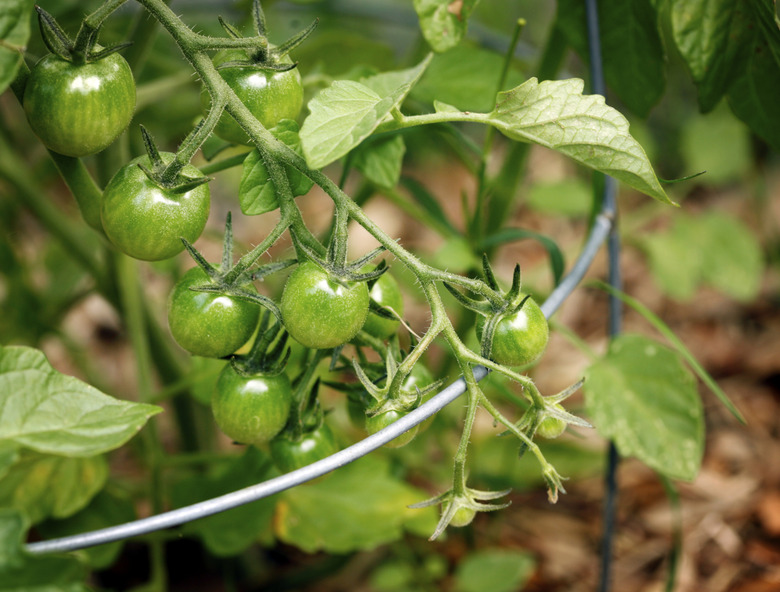Can Bone Meal Be Used As A Vegetable Fertilizer?
Bone meal, the ground-up animal bones left over from slaughterhouses, has long been touted as an organic fertilizer rich in phosphorous and calcium. Said to help stimulate root growth and promote stronger plants, this soil amendment has become a popular recommendation for organic gardening. **While there are benefits to using bone meal in some vegetable gardens, several factors should be considered in evaluating its overall impact as a fertilizer.**
Step 1
Plants need 16 different essential nutrients. Three are considered macro-nutrients, because they are needed in larger quantities: nitrogen (N), phosphorus (P) and potassium (K). Fertilizers that are considered "complete" are ones that have all three of these essential macro-nutrients present. On fertilizer packaging, their percentage is represented by three numbers, 7-7-7, for example, to show that there are equal parts of N, P and K in that fertilizer. **Bone meal is considered an incomplete fertilizer, possessing only high levels of phosphorous and just a trace of nitrogen,** around 1-15-0, depending on how it's processed. It is also high in calcium, another nutrient plants need. In garden soil, however, phosphorous and calcium are usually found in adequate amounts unless the soil has been used for several growing seasons without any fertilizer. Additionally, high levels of phosphorous can actually be toxic to some plants and may reduce the number of microscopic fungi that help build soil over time.
Step 2
- Plants need 16 different essential nutrients.
- In garden soil, however, phosphorous and calcium are usually found in adequate amounts unless the soil has been used for several growing seasons without any fertilizer.
pH and Phosphorous
Step 1
The best way to determine if the addition of phosphorous through the application of bone meal will be beneficial is to test your soil. Simple kits, available at garden centers, can detect levels of nitrogen, phosphorous and potassium in soil, as well as pH — another important factor to consider before fertilizing your vegetable garden. The pH scale is used to determine how acidic or alkaline soils are, which can impact the availability of nutrients and general plant health. Phosphorous from bone meal is only available to plants in soils with a pH below 7.0. The pH of soil can be amended in a variety of ways, but in areas with slightly alkaline soils, bone meal may not be the best choice of fertilizer compared to other animal byproducts such as compost or fish emulsion.
Different Types of Bone Meal
Step 1
Traditionally, bone meal was dried and ground from the bones left over from animal processing. In recent years, concern over such pathogens as those that cause "Mad Cow" disease and salmonella have lead to the materials being sterilized through steam pasteurization. This process eliminates the possible risk of disease among livestock, but also reduces the trace amounts of nitrogen found in traditional bone meal. Commercially available bone meal will have been sterilized through this process, though there are recipes for making your own unsterilized bone meal.
Step 2
- The best way to determine if the addition of phosphorous through the application of bone meal will be beneficial is to test your soil.
- The pH of soil can be amended in a variety of ways, but in areas with slightly alkaline soils, bone meal may not be the best choice of fertilizer compared to other animal byproducts such as compost or fish emulsion.
Plants That May Benefit
Step 1
Plants that benefit most from the application of bone meal are ones that use high levels of calcium. Tomatoes, peppers, melons, celery and cabbage all benefit from additional calcium. Plants that do not benefit from excess phosphorous include root crops like beets or carrots. Avoid using it with plants that use bacteria in soil that help fix nitrogen like beans, peas or any other legume.
Applying Bone Meal
Step 1
Bone meal is applied by mixing the granular powder into the top layer of soil. As a slow-release fertilizer, nutrients leach into the soil with each watering. This can be done prior to planting by mixing the amount recommended on packaging into soil as you sow seeds or transplant seedlings. You can also add bone meal during the growing season by top dressing with a granular fertilizer sprinkled evenly on the soil surface around plants or through *side dressing,* where the fertilizer is laid in a line just to the side of plants. Try not to touch stems directly with the fertilizer, and water immediately afterwards for best results.
Step 2
- Plants that benefit most from the application of bone meal are ones that use high levels of calcium.
- You can also add bone meal during the growing season by top dressing with a granular fertilizer sprinkled evenly on the soil surface around plants or through *side dressing,* where the fertilizer is laid in a line just to the side of plants.
